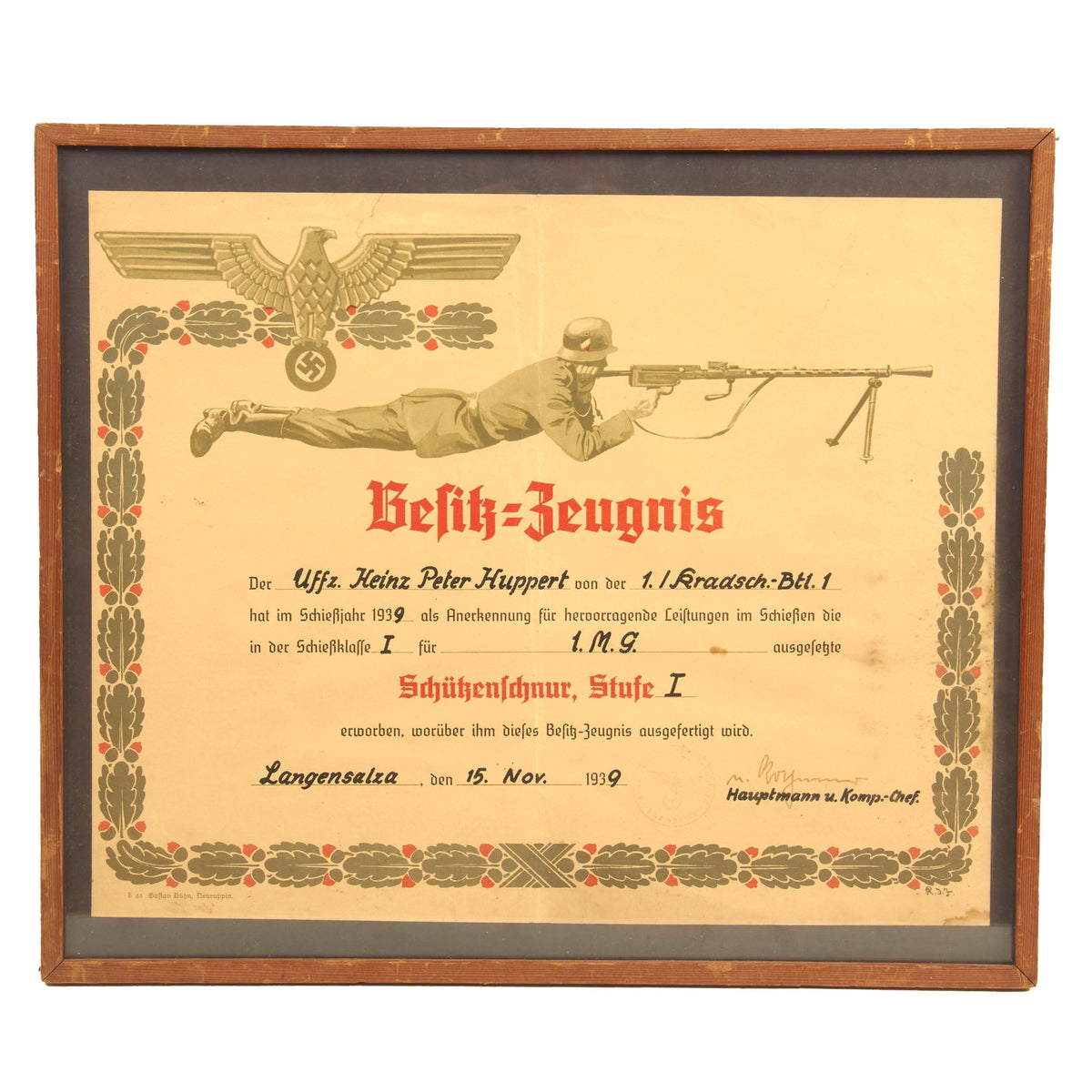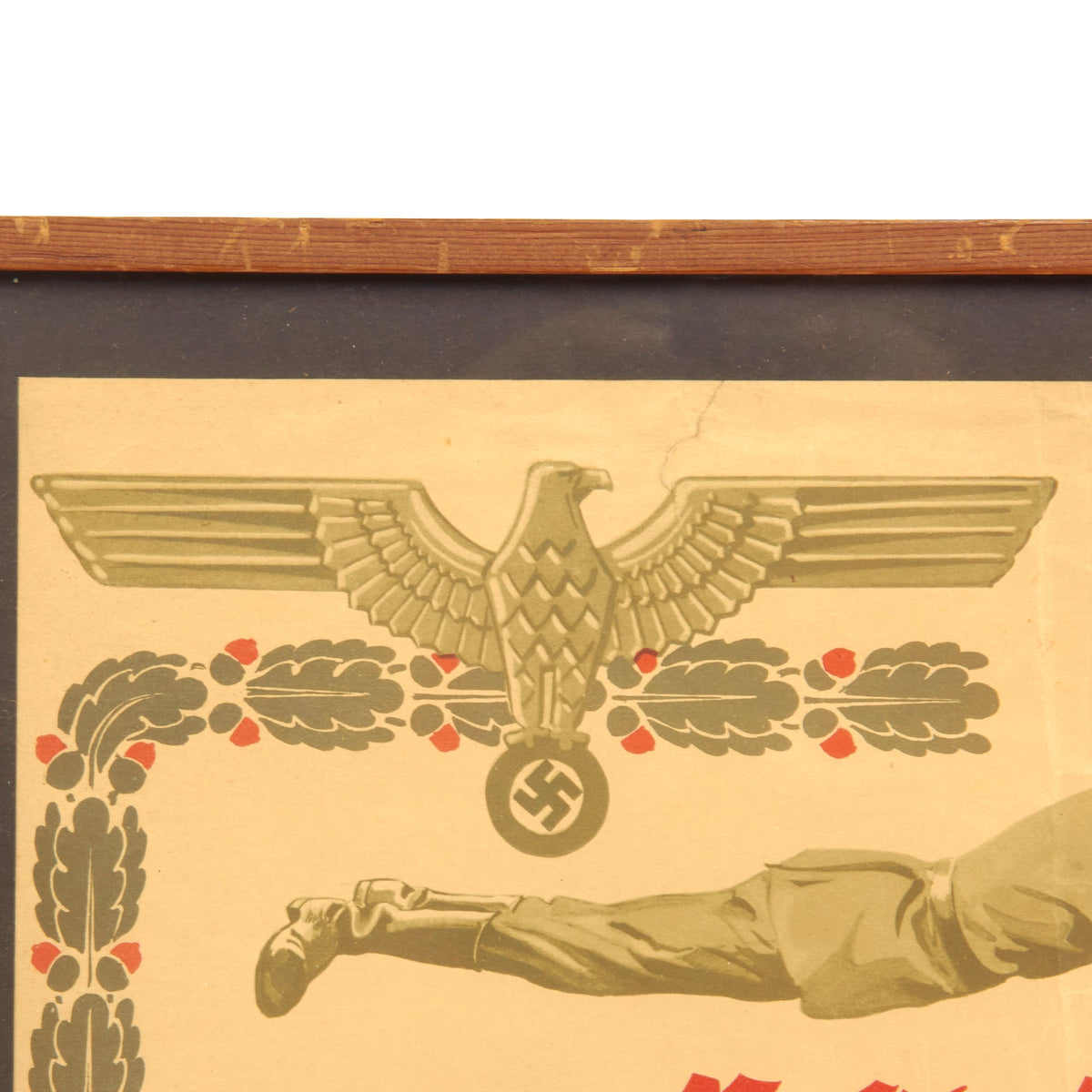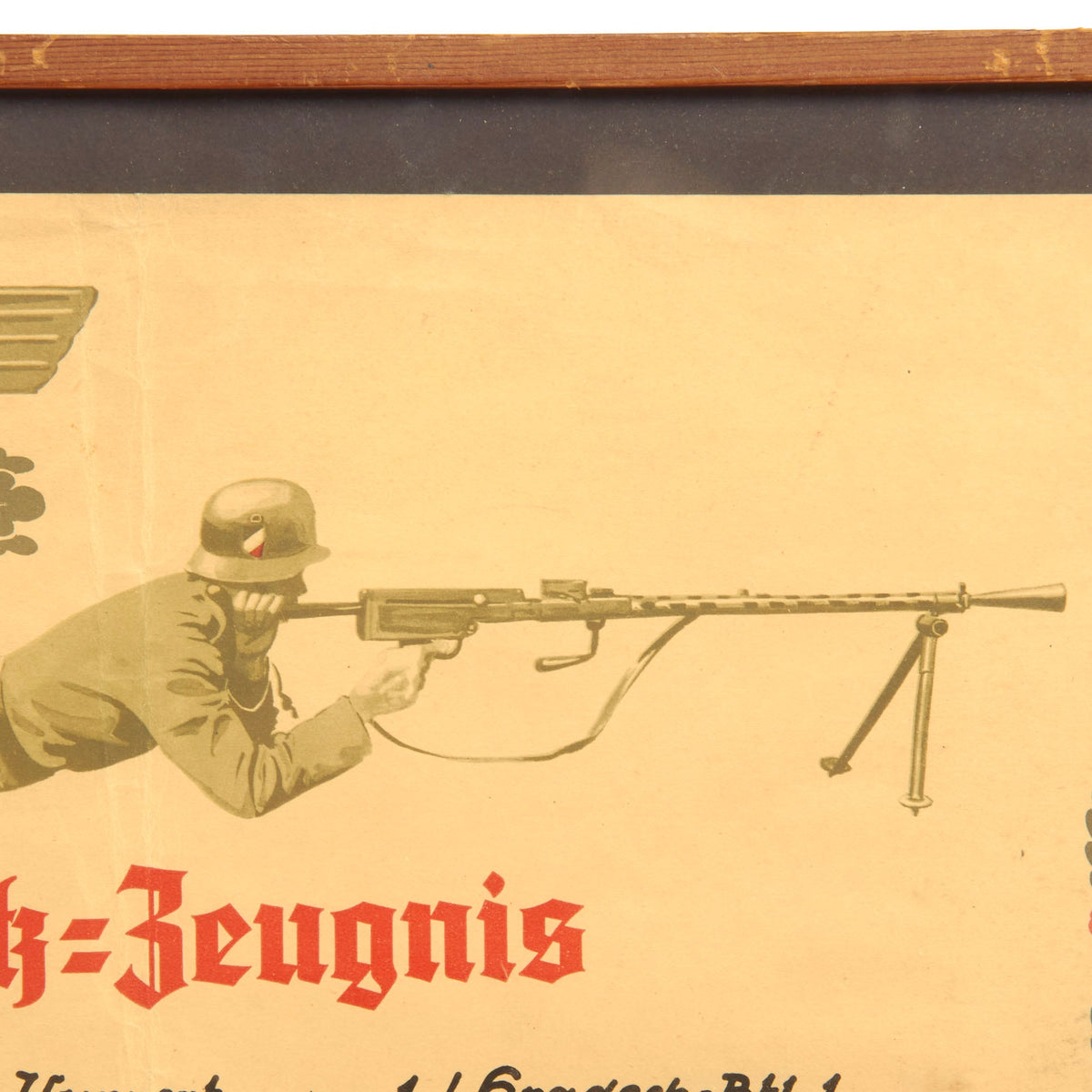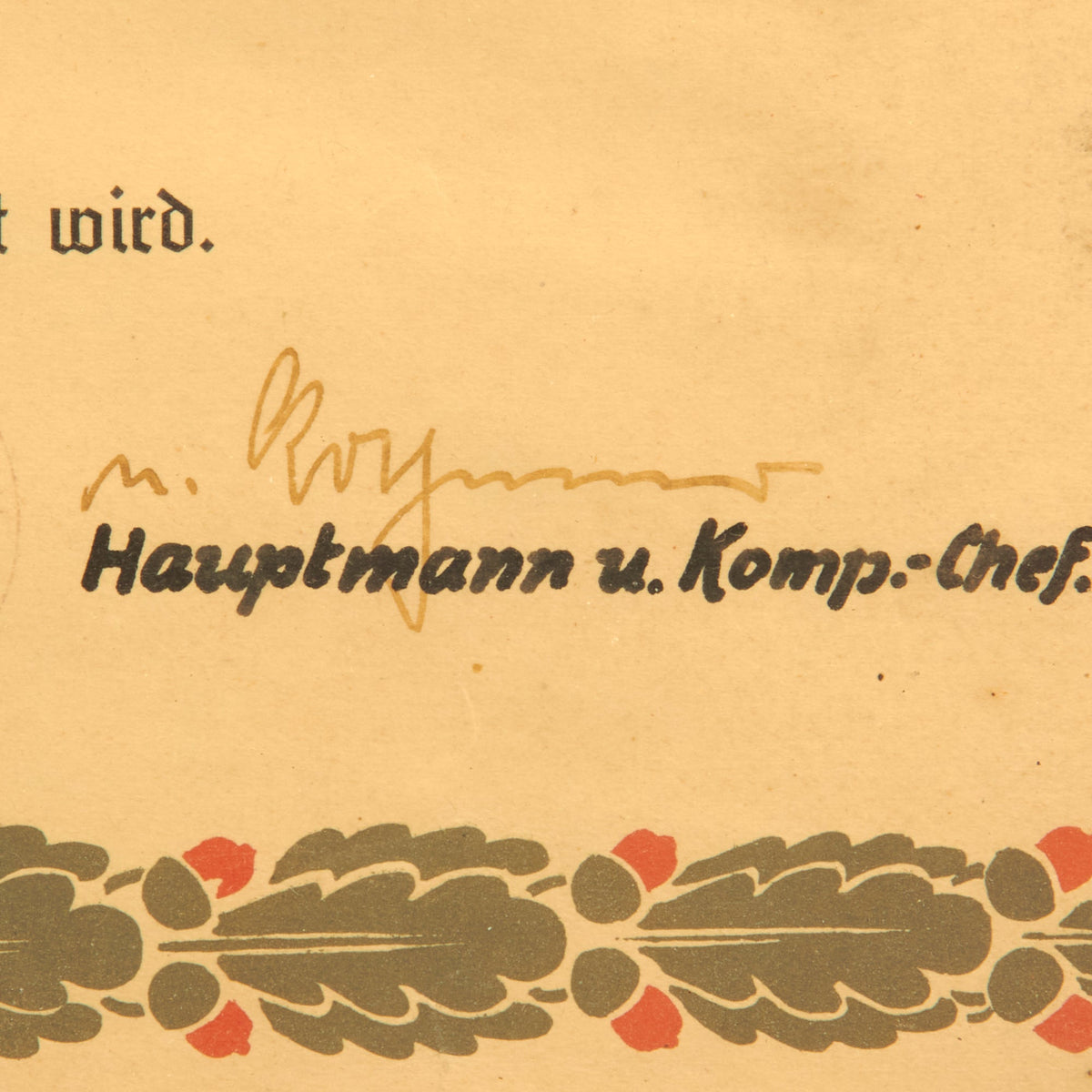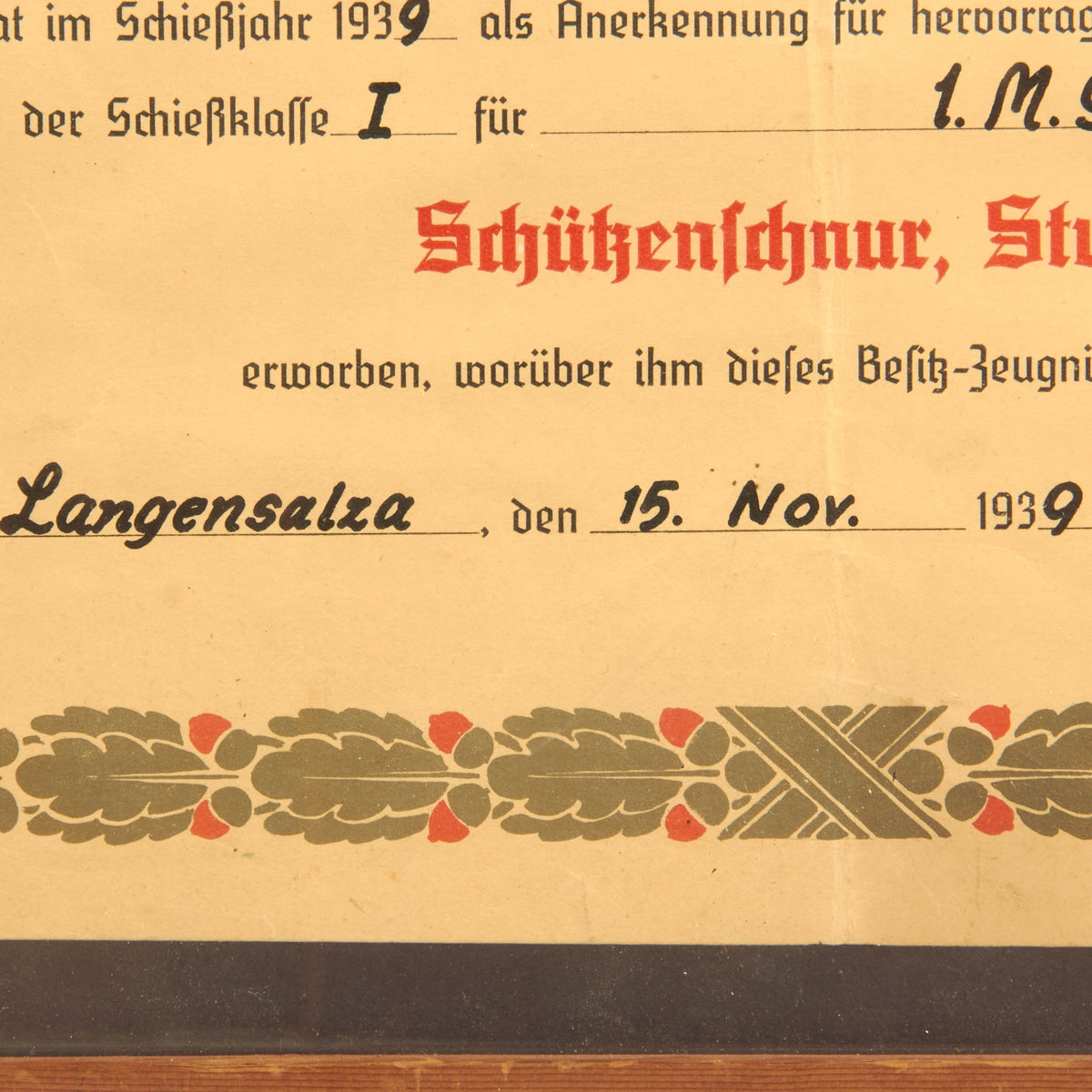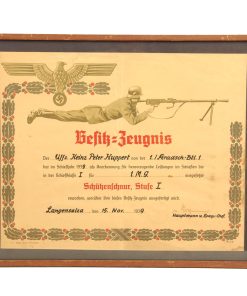Original German WWII Framed Machine Gun Marksmanship Lanyard Award Document – 14 1/4″ x 16 3/4″ Original Items
$ 195,00 $ 78,00
Original Item: One-of-a-kind. Here we have a very nice and somewhat hard to find piece of German WWII Militaria: the original award document for a Marksmanship Lanyard, issued for proficiency with a Machine Gun. The document shows a soldier in the prone position behind a German MG 13 Machine gun, with an oak leaf and acorn border around the entire document. In the upper left hand corner is a Wehrmachtadler Armed Forces Eagle. The document measures 15″ x 12 1/4″, and is glazed and framed in a simple 14 1/4″ x 16 3/4″ wooden frame.
The text of the award is printed with written in particulars, and reads as follows:
Besitz=Zeugnis
Der Uffz. Heinz Peter Huppert von der 1. / Kradsch.-Btl. 1
hat im Schießjahr 1939 als Anerkennung für hervorragende Leistungen im Scheißen die
in der Schießklasse I fur 1. M.G. ausgesetzte
Schützenschnur, Stufe I
erworben, worüber ihm dieses Besitz-Zeugnis ausgefertigt wird.
This basically translates to: “Uffz. Heinz Peter Huppert from the 1st / Kradsch.-Btl. 1 has in the shooting year 1939 in recognition of his excellent performance shooting class I for 1.M.G. is allowed to wear the Marksmanship Lanyard, Grade 1, for which this certificate of ownership is issued to him.” Below this it gives the location of Langensalza and a date of 15. Nov. 1939, along with the correct stamp and signature of the Captain and Company Chief.
Definitely some great research potential here! Ready to display!
The German Armed Forces Badge for Weapons Proficiency (German: Schützenschnur) is a decoration of the Bundeswehr, the armed forces of the Federal Republic of Germany.
The decoration is awarded to German military personnel of all grades but is only allowed to be worn by enlisted members. The German armed forces regulations point out that “the Schützenschnur is a decoration for weapons proficiency for enlisted soldiers.” Officers can receive the award, although it is not currently authorized to be worn on their uniforms. Foreign military members also may be awarded the badge. The German military regulation on officers still applies, permitting only enlisted members to wear the badge.
The history of the Schützenschnur dates back to the Eighty Years’ War where Spanish troops were ordered to hang any Dutch person who carried a musket. Therefore Spanish musketeers began to carry ropes which were often carried over one shoulder. Awarding a cord as a decoration began in the early 18th century in Prussia under Frederick William I of Prussia. With the reorganization of the Prussian Army under Gerhard von Scharnhorst the Schützenschnur became an official military award.
The Reichswehr and later the Wehrmacht adapted the Schützenschnur as an award for proficiency in marksmanship. The award existed in 12 different levels with different versions for infantry and armored troops. In 1957 the Bundesgrenzschutz introduced the Schützenschnur. A similar decoration existed within the East German National People’s Army and the Border Troops of the German Democratic Republic.
Fast Shipping with Professional Packaging
Thanks to our longstanding association with UPS FedEx DHL, and other major international carriers, we are able to provide a range of shipping options. Our warehouse staff is expertly trained and will wrap your products according to our exact and precise specifications. Prior to shipping, your goods will be thoroughly examined and securely secured. We ship to thousands clients each day across multiple countries. This shows how we're dedicated to be the largest retailer on the internet. Warehouses and distribution centres can be located throughout Europe as well as the USA.
Note: Orders with more than one item will be assigned a processing date depending on the item.
Before shipping before shipping, we'll conduct a thorough inspection of the items you have ordered. Today, the majority of orders will be delivered within 48 hours. The delivery time will be between 3-7 days.
Returns
The stock is dynamic and we cannot completely manage it because multiple stakeholders are involved, including our factory and warehouse. So the actual stock may alter at any time. It's possible that you may not receive your order once the order has been made.
Our policy is valid for a period of 30 days. If you don't receive the product within 30 days, we are not able to issue a refund or an exchange.
You can only return an item if it is unused and in the same state as the day you received it. You must have the item in its original packaging.
Related products
Uncategorized
Uncategorized
Uncategorized
Band of Brothers ORIGINAL GERMAN WWII Le. F.H. 18 10.5cm ARTILLERY PIECE Original Items
Uncategorized
Uncategorized
Uncategorized
Angolan Rebel 1970s era 60mm Inert Display Mortar from Angolan Civil War Original Items
Uncategorized
Armored Burgonet Helmet & Polearm from Scottish Castle Leith Hall Circa 1700 Original Items
Uncategorized
Uncategorized
Uncategorized
Uncategorized
Uncategorized
Uncategorized
Uncategorized
Uncategorized
Uncategorized
Australian WWII Owen MK1 Machine Carbine SMG Custom Fabricated Replica with Sling Original Items
Uncategorized
Uncategorized
